I Don't Know How Accurate Some Of These Are, But They Can Be Useful
I don't know how accurate some of these are, but they can be useful

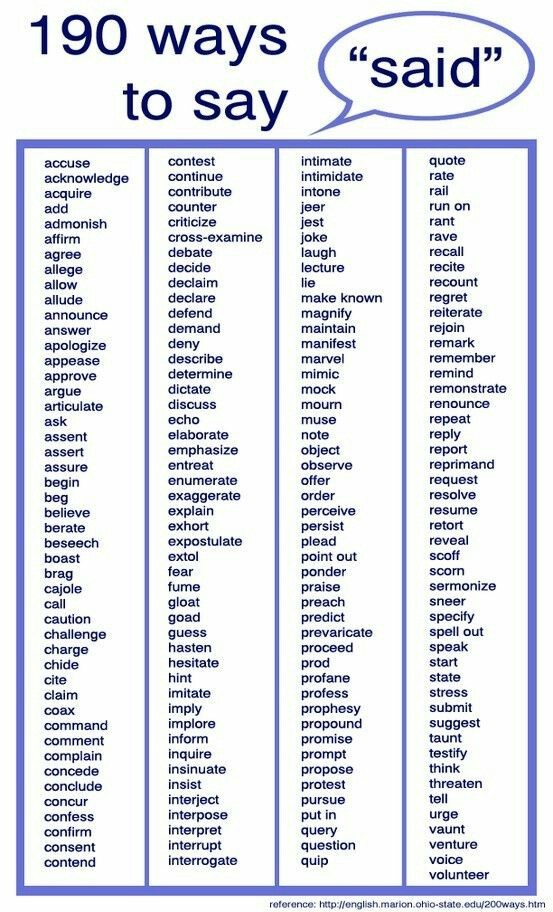



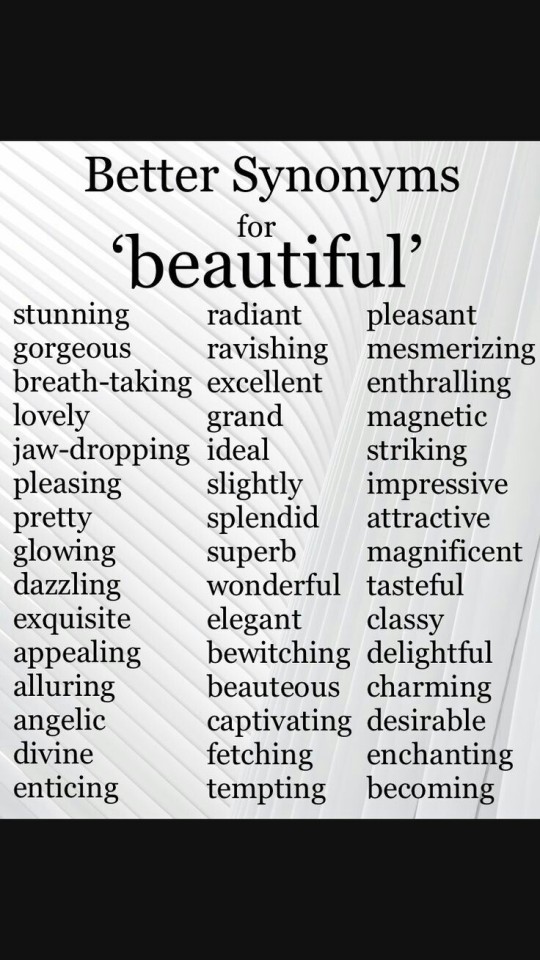
More Posts from Writersreferencez and Others
Character Tip
Realistic characters have contradictions. Exceptions to rules. Maybe they’re mostly nonviolent, but they’ll punch you if you insult their friend. Maybe they’re afraid of spiders, but aren’t afraid to kill a spider for their younger sibling.
In short, don’t be afraid to have characters who can’t be defined by a character fact sheet.
Writing Fights That Are More Than Just Punches
REAL fights aren’t about the dishes in the sink. They’re about what the dishes represent. Neglect. Disrespect. One more little way you made me feel like I don’t matter.
When characters explode, make sure it’s a culmination, not a random Tuesday outburst. Sow those seeds way earlier. Every ignored text. Every moment one character flinched but didn’t speak. Let it simmer like a pot left on the stove too long — and then blow the lid off.
“You left your socks on the floor again!” Translation: You stopped caring about making me feel wanted.
╰ The “Fight Like Yourself” Principle Your shy, conflict-avoidant character isn’t going to suddenly monologue like a Shakespeare villain. They’re going to stutter. Misfire. Maybe say something stupid and instantly regret it. Your cocky, snarky character? They’ll joke until they’re cornered — and then bite. HARD.
Write fights in a way that honors your characters’ personalities even when they’re falling apart. Actually, especially when they’re falling apart.
The sarcastic one cracks a joke that lands wrong. And when the other person flinches, really flinches, the jokester looks like they just slapped themselves in the face.
╰ The "Weaponized Vulnerability" Strike Want a fight that stings? Let one character use something the other trusted them with, something private, something raw as a weapon. It’s dirty. It’s low. It feels like betrayal because it is.
“You know why nobody sticks around, right? Even your mom didn’t.” (The one thing they confessed one night, drunk and shaking. Now thrown back like a grenade.)
╰ The “No Winner, Only Wreckage” Outcome A good fight doesn’t end clean. Nobody walks away feeling like they "won." They walk away wrecked. Lonely. Furious. Guilty. Sometimes victorious in the worst possible way. If both characters don’t feel like they lost something by the end of it, time to dig deeper.
One character storms out thinking, I showed them. But on the way home, they realize their hands won’t stop shaking. And the empty seat beside them has never felt so heavy.
╰ The “Body Language Screams Louder Than Words” Method Fights aren’t just yelling. It’s clenching fists that don’t throw punches. It’s pacing like a caged animal. It’s backing into a corner you don’t even realize you’re in. Describe the tension bleeding out of their bodies.
The vein in his temple throbs. She’s standing stiff as a lamppost, arms folded so tight she might snap her own bones. The air between them buzzes with too many things left unsaid.
╰ Some Types of Fights to Play With...
The Blow-Up Over Nothing: Petty argument becomes nuclear meltdown because of all the built-up resentment.
The Long-Slow Death: Cold silences. Sharp comments. No shouting — just a slow suffocation.
The Misfire: They’re mad at someone else, but they unleash it on the wrong person. (And regret it instantly.)
The Final Straw: One wrong move, one broken promise too many, and snap — years of loyalty gone in a second.
A good fight scene shouldn’t just bruise skin. It should bruise souls.
Make your characters shatter themselves a little bit. Make the reader beg them to fix it and wonder if they ever truly can.
One of the best tips for writing descriptions of pain is actually a snippet I remember from a story where a character is given a host of colored pencils and asked to draw an egg.
The character says that there’s no white pencil. But you don’t need a white pencil to draw a white egg. We already know the egg is white. What we need to draw is the luminance of the yellow lamp and the reflection of the blue cloth and the shadows and the shading.
We know a broken bone hurts. We know a knife wound hurts. We know grief hurts. Show us what else it does.
You don’t need to describe the character in pain. You need to describe how the pain affects the character - how they’re unable to move, how they’re sweating, how they’re cold, how their muscles ache and their fingers tremble and their eyes prickle.
Draw around the egg. Write around the pain. And we will all be able to see the finished product.
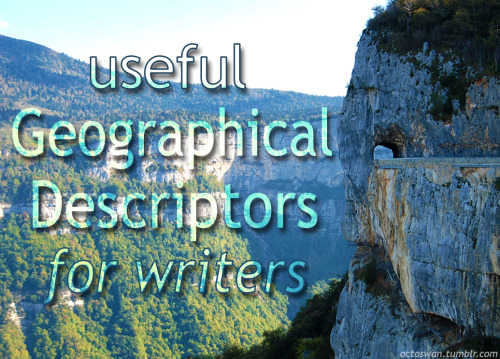


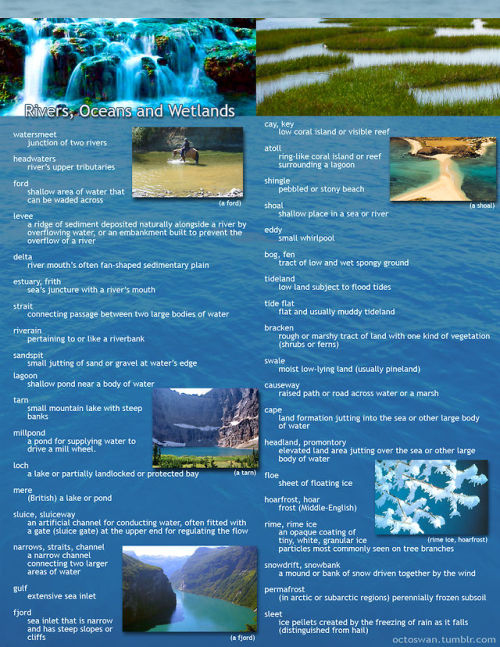
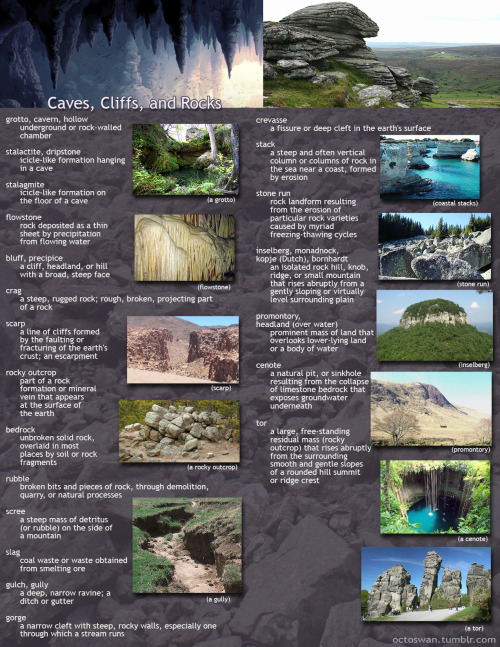
I made these as a way to compile all the geographical vocabulary that I thought was useful and interesting for writers. Some descriptors share categories, and some are simplified, but for the most part everything is in its proper place. Not all the words are as useable as others, and some might take tricky wording to pull off, but I hope these prove useful to all you writers out there!
(save the images to zoom in on the pics)
10 Non-Lethal Injuries to Add Pain to Your Writing
While lethal injuries often take center stage, non-lethal injuries can create lasting effects on characters, shaping their journeys in unique ways. If you need a simple way to make your characters feel pain during a scene, here are some ideas:
Sprained Ankle
A common injury that can severely limit mobility, forcing characters to adapt their plans and experience frustration as they navigate their environment.
Rib Contusion
A painful bruise on the ribs can make breathing difficult and create tension, especially during action scenes, where every breath becomes a reminder of vulnerability.
Concussion
This brain injury can lead to confusion, dizziness, and mood swings, affecting a character’s judgment and creating a sense of unpredictability in their actions.
Fractured Finger
A broken finger can complicate tasks that require fine motor skills, causing frustration and emphasizing a character’s dependence on their hands.
Road Rash
The raw, painful skin resulting from a fall can symbolize struggle and endurance, highlighting a character's resilience in the face of physical hardship.
Shoulder Dislocation
This injury can be excruciating and often leads to an inability to use one arm, forcing characters to confront their limitations while adding urgency to their situation.
Deep Laceration
A cut that requires stitches can evoke visceral imagery and tension, especially if the character has to navigate their surroundings while in pain.
Burns
Whether from fire, chemicals, or hot surfaces, burns can cause intense suffering and lingering trauma, serving as a physical reminder of a character’s past mistakes or battles.
Pulled Muscle
This can create ongoing pain and restrict movement, providing an opportunity for characters to experience frustration or the need to lean on others for support.
Tendonitis
Inflammation of a tendon can cause chronic pain and limit a character's ability to perform tasks they usually take for granted, highlighting their struggle to adapt and overcome.
Looking For More Writing Tips And Tricks?
Check out the rest of Quillology with Haya; a blog dedicated to writing and publishing tips for authors! Instagram Tiktok
hey writers! OneLook Thesaurus lets you find that word you can’t think of but can describe! go check it out!



There is no reason not to love your writing. You did it. You spent time on it. Of course you should talk about it. No. It’s not boasting, nor are you self obsessed. It’s yours. You spent time on it. Not them. Post about your art. Share with everyone. Because it is amazing.
Writing Description Notes:
Updated 9th September 2024 More writing tips, review tips & writing description notes
Facial Expressions
Masking Emotions
Smiles/Smirks/Grins
Eye Contact/Eye Movements
Blushing
Voice/Tone
Body Language/Idle Movement
Thoughts/Thinking/Focusing/Distracted
Silence
Memories
Happy/Content/Comforted
Love/Romance
Sadness/Crying/Hurt
Confidence/Determination/Hopeful
Surprised/Shocked
Guilt/Regret
Disgusted/Jealous
Uncertain/Doubtful/Worried
Anger/Rage
Laughter
Confused
Speechless/Tongue Tied
Fear/Terrified
Mental Pain
Physical Pain
Tired/Drowsy/Exhausted
Eating
Drinking
Warm/Hot
25 hot traits for your character :
(feel free to use <3 yall gotta agree with me on the 10th, 11th, 12th and from 17th to 21st cus :) tag me yall )
they hold eye contact whenever you talk
they love when you wear their clothes. [hehe]
they get physically clingy whenever they're jealous [ holy god]
always pulls you into a random embrace.
they manspread alot with a sultry gaze >> [imagine that gaze and that fucking smirk]
likes to tease you a lott
or easily blushes when you teach them ♡
holding gazes while kissing your body [highway looks mad comfyy rn]
"look at me when I'm making you feel good, baby" *coughing violently*
vocally expressive, isn't afraid of moaning loud > <
loves keeping you close to them
"if you ask me to fucking kneel, then I would, my love."
clicking their tongue against their cheek when they're mad or jealous !!!!!
kissable lips. sultry gaze, seductive smirk. [weak in em knees fr]
"say that again, mi sol."
loves to showcase you.
always has the top button of their shirt open [banging my head aaaaa]
slightly biting their lower lip when they smile
rolls their tongue over their lips often
sexy fingers !!!!
baby face, raspy and deep voice > \\ <
knows the effects of their actions over you [ do yk my last name?? its *yours* ;) ]
smells good 24/7
multilingual. (now tell me yall dont find multilingual people hot af-)
skilled. an all-rounder irl. smart and skilled, can easily save the world singlehandedly fr
How to Make Fictional Settings Real (Even If You’re Faking the Whole Thing)
➤ Real Estate Listings (Yes, Seriously)
Looking up local listings in a place similar to your fictional town or city gives you surprising insight—average home styles, neighborhood layouts, what “affordable” means in that region, even local slang in the listings. + Great for, grounding your setting in subtle realism without hitting readers over the head with exposition.
➤ Google Street View (Time to Creep Around Like a Setting Spy)
Drop into a random street in a town that resembles your fictional setting. Walk around virtually. Notice what's boring.Trash cans, streetlights, sidewalk cracks, old ads. + Great for: figuring out what makes a setting feel “normal” instead of movie-set polished.
➤ Local Newspapers or Small Town Reddit Threads
Want voice? Culture? Weird local drama? This is where it lives. What’s in the classifieds? What’s pissing people off at town hall? + Great for: authentic small-town flavor, conflict inspiration, and the kind of gossip that fuels subplot gold.
➤ Fantasy Map Generator Sites (Even for Contemporary Settings!)
Not just for epic quests. Generating a map, even a basic one, can help you stop mentally teleporting your characters between places without any sense of space or distance.+ Great for: figuring out how long it takes to get from the protagonist’s house to that cursed gas station.
➤ Music from or Inspired by the Region/Culture
Even fictional cities deserve a soundtrack. Listen to regional or cultural playlists and let the vibe soak into your setting. What kind of music would be playing in your character’s world? + Great for: writing atmospherically and getting in the right emotional headspace.
➤ Online Menus from Local Diners, Restaurants, or Cafés
You want a setting that tastes real? Look at what people are actually eating. + Great for: writing scenes with meals that aren’t just “some soup” or “generic coffee.” (Also, bonus points for fictionalizing weird specials: “Tuesday Fish Waffle Night” is canon now.)
➤ Yelp Reviews (Especially the One-Star Ones)
Looking for a spark of chaos? One-star Yelp reviews will tell you what your characters complain about and where the best petty drama lives. + Great for: worldbuilding quirks, local tensions, and giving your town character.
➤ Real Estate “Before/After” Renovation Blogs
You’ll find the bones of houses, historical details, and how people preserve or erase the past. + Great for: backstory-laced settings, haunted houses, or any structure that’s more than just a place, it’s a story.
➤ Old Travel Books or Tourism Brochures
Especially the outdated ones. What used to be considered “the pride of the town”? What’s still standing? What was erased? + Great for: layering a setting with history, especially for second-generation characters or stories rooted in change.
-
 lastweeksshirttonight liked this · 3 months ago
lastweeksshirttonight liked this · 3 months ago -
 jyuugoya liked this · 3 months ago
jyuugoya liked this · 3 months ago -
 king-krist liked this · 3 months ago
king-krist liked this · 3 months ago -
 fridaycanbesadsometimes liked this · 4 months ago
fridaycanbesadsometimes liked this · 4 months ago -
 fruitppunch liked this · 4 months ago
fruitppunch liked this · 4 months ago -
 raekixsworld liked this · 4 months ago
raekixsworld liked this · 4 months ago -
 your1-local-weirdo liked this · 5 months ago
your1-local-weirdo liked this · 5 months ago -
 mzafuto reblogged this · 5 months ago
mzafuto reblogged this · 5 months ago -
 mzafuto liked this · 5 months ago
mzafuto liked this · 5 months ago -
 blackenedsheep reblogged this · 6 months ago
blackenedsheep reblogged this · 6 months ago -
 marvelisttea liked this · 6 months ago
marvelisttea liked this · 6 months ago -
 enchantedfeathers reblogged this · 7 months ago
enchantedfeathers reblogged this · 7 months ago -
 koolgeek4000 reblogged this · 8 months ago
koolgeek4000 reblogged this · 8 months ago -
 koolgeek2000 liked this · 8 months ago
koolgeek2000 liked this · 8 months ago -
 hangoutwithmika reblogged this · 8 months ago
hangoutwithmika reblogged this · 8 months ago -
 kenacoki liked this · 9 months ago
kenacoki liked this · 9 months ago -
 blue-flamed-phoenix liked this · 10 months ago
blue-flamed-phoenix liked this · 10 months ago -
 starrolling liked this · 10 months ago
starrolling liked this · 10 months ago -
 actuallysolace liked this · 1 year ago
actuallysolace liked this · 1 year ago -
 venuswolf67 liked this · 1 year ago
venuswolf67 liked this · 1 year ago -
 holylulusworld liked this · 1 year ago
holylulusworld liked this · 1 year ago -
 pishikuu liked this · 1 year ago
pishikuu liked this · 1 year ago -
 sulicide liked this · 1 year ago
sulicide liked this · 1 year ago -
 twosetglasses reblogged this · 1 year ago
twosetglasses reblogged this · 1 year ago -
 twosetglasses liked this · 1 year ago
twosetglasses liked this · 1 year ago -
 freddie6964 liked this · 1 year ago
freddie6964 liked this · 1 year ago -
 beansprococanwe liked this · 1 year ago
beansprococanwe liked this · 1 year ago -
 butterflyslinky liked this · 1 year ago
butterflyslinky liked this · 1 year ago -
 spn-fanfic-reblog-writes reblogged this · 1 year ago
spn-fanfic-reblog-writes reblogged this · 1 year ago -
 rissamarabbalt liked this · 1 year ago
rissamarabbalt liked this · 1 year ago -
 metcacenahund liked this · 1 year ago
metcacenahund liked this · 1 year ago -
 krourou2 liked this · 1 year ago
krourou2 liked this · 1 year ago -
 nathanbatemanfucker liked this · 1 year ago
nathanbatemanfucker liked this · 1 year ago -
 tramkontico liked this · 1 year ago
tramkontico liked this · 1 year ago -
 islengali liked this · 1 year ago
islengali liked this · 1 year ago -
 n3vill liked this · 1 year ago
n3vill liked this · 1 year ago -
 galacticskull reblogged this · 1 year ago
galacticskull reblogged this · 1 year ago -
 ladyimaginarium reblogged this · 1 year ago
ladyimaginarium reblogged this · 1 year ago -
 bobfloydsbabe liked this · 1 year ago
bobfloydsbabe liked this · 1 year ago -
 syn-chronic-city liked this · 1 year ago
syn-chronic-city liked this · 1 year ago